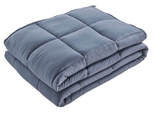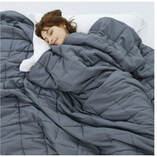|
Under pressure: The science behind weighted blankets and stress relief The idea is simple: the pressure of the blanket simulates the feeling of receiving a hug. From Aged Care New Zealand Issue 02 2022  Simple yet effective, the weighted blanket is an impressive innovation in relieving anxiety and symptoms of other conditions. The idea behind it is simple: the pressure of the blanket simulates the feeling of receiving a hug. For many weighted blanket users, this leads to relief and calmness. But this innovation is far from new. In the 1980s, Temple Grandin, a scientist and animal behaviourist, discovered the benefits of pressure sensation. To make the beef industry more humane, Grandin observed that frightened cows would regain calm after being pushed tightly into a squeeze chute, for example. From these observations, she went on to develop a hug machine that duplicated this calming pressure. This was the first developed to ease the symptoms of autism, a diagnosis that Temple Grandin shares. Recently, there has been a resurgence of interest in this sensory therapy modality, with weighted blankets becoming popular in the mainstream. Let’s look at everything you need to know about weighted blankets – and if you could benefit from using one. What is a weighted blanket? A weighted blanket is a therapeutic tool similar to a conventional blanket in all but its weight. Often, they weigh anywhere from 2kg to 13kg. The blanket is often filled with glass beads or plastic pallets. The concept? The blanket is heavy enough to exert pressure on you much like getting a long-lasting hug after a rough day. Who can use a weighted blanket? The short answer? Anyone can use a weighted blanket. Regarding more specific use cases, occupational therapists who work with kids tend to use weighted blankets as a treatment option for sensory activities. This can include various conditions such as autism or attention deficit hyperactive disorder (ADHD). This easy-to-use tool may also help with the following:
Recent research efforts have focused on better understanding the mechanism of weighted blanket therapy for relieving the symptoms of the conditions mentioned above. In 2020, Swedish researchers conducted a study to determine facets of that effectiveness. They found that weighted blankets improved sleep among people with ADHD, generalised anxiety disorder, bipolar disorder, and depressive disorder. So how do they work? The mechanism of how weighted blankets work is not well studied or understood currently. Weighted blankets are used in therapy as part of the sensory integration therapy model. This model is based on integrating inputs from two systems:
The main benefits of using a weighted blanket provide security and comfort Swaddling a newborn baby helps them sleep soundly at night, and this is because of the sense of security the tight swaddle provides. A weighted blanket works under a similar principle, helping you sleep securely and comfortably throughout the night. Reduce stress and anxiety levels Stress and anxiety are the most significant contributors to interrupted sleep. Constant worry and fear make it hard to fall asleep during the night. In turn, sleep deprivation can aggravate an individual’s anxiety levels – so it’s essentially a vicious cycle. A weighted blanket helps by applying pressure to soothe your anxiety and help you rest.  Improve sleep quality Some research studies have demonstrated the benefit of weighted blankets on improving sleep and reducing the impact of insomnia. The mechanism behind this is not yet known. However, it is thought to be mediated by serotonin, cortisol, and melatonin hormones. The pressure created by the blanket’s weight can go a long way toward improving your overall sleep quality. Calm the nervous system Weighted blankets help restore calm in your nervous system by applying even pressure on your body. Sleeping with an overactive nervous system can be challenging. Luckily, weighted blankets are a quick and effective means of overcoming this hurdle. According to a study, 63 per cent of participants stated that heavy blankets helped lower their anxiety levels after just five minutes of use. How to choose the best weighted blanket for you. As the COVID-19 pandemic continues, stress and anxiety are still taking centre stage, causing many of us to revisit our mental health. That said, a weighted blanket might be a great tool for you. So, how do you pick the best option? Consider the following factors. Blanket weight The average weight of weighted blankets ranges from 2kg to 13kg. You should select a weighted blanket that weighs no more than 10 percent of your body weight. Weighted blankets for children weigh close to 2kg, and adult blankets range from 2kg to 13kg. Consider getting a lighter blanket for users with mobility issues. Although the pressure of the blanket has its benefits, it can be unsafe to apply too much pressure with a weighted blanket that is too heavy. That’s why the 10 per cent rule is recommended. If you have any concerns or questions about which weight is right for you, speak with your doctor or ask to be referred to a therapist who specialises in sensory integration therapy.
Weighted blanket material Weighted blankets are filled with two types of material: plastic pellets or glass beads. Glass beads are smaller – but heavier than plastic pallets. That small size has an advantage in that the blanket appears thinner. In contrast, plastic pellets are bigger, making the blanket a bit bulkier. However, blankets with plastic pallets are considerably cheaper since plastic is inexpensive compared to glass. Some weighted blankets come with other materials, such as polyester fibrefill or fleece lining, for an extra layer of warmth. If you’re planning to use the blanket during the cold winter months, this might be a nice perk. Removable cover Due to the weight of the blankets, they are bulky and hard to wash, which means a removeable cover is ideal. Cotton covers make for cool, breathable blankets, while other fabrics may best suit that warm and cosy feel. Sometimes, sellers will price covers as an add-on, so never assume your blanket comes with a removable cover. Adapted from an article by Esteban Vaquera. Medically reviewed by Brittany Stopa, MPH. Available at: www.symptomfind.com Comments are closed.
|
AuthorShonagh O'Hagan Archives
July 2024
|

 RSS Feed
RSS Feed